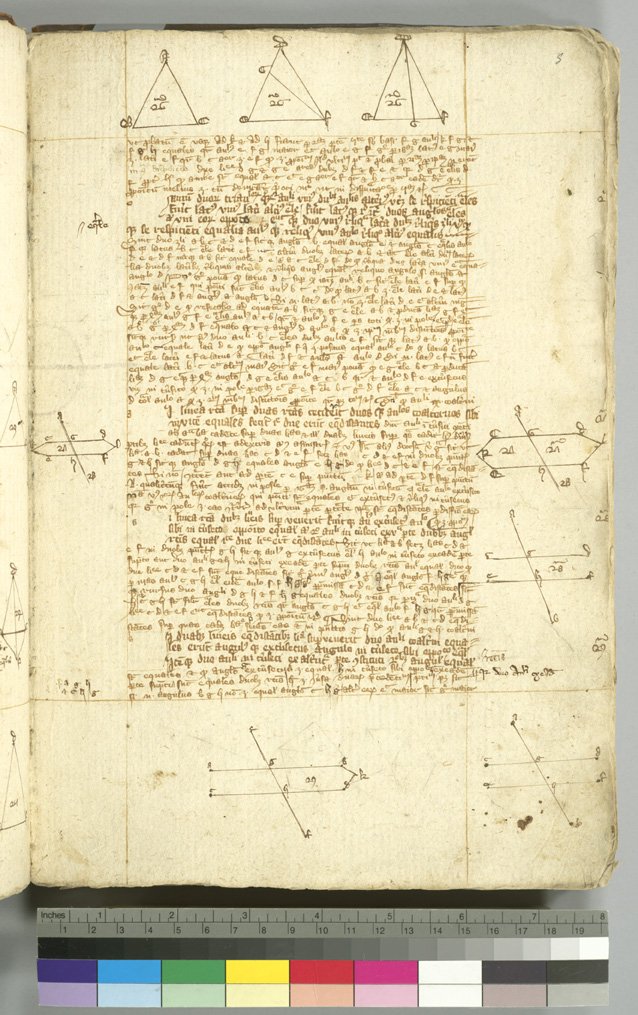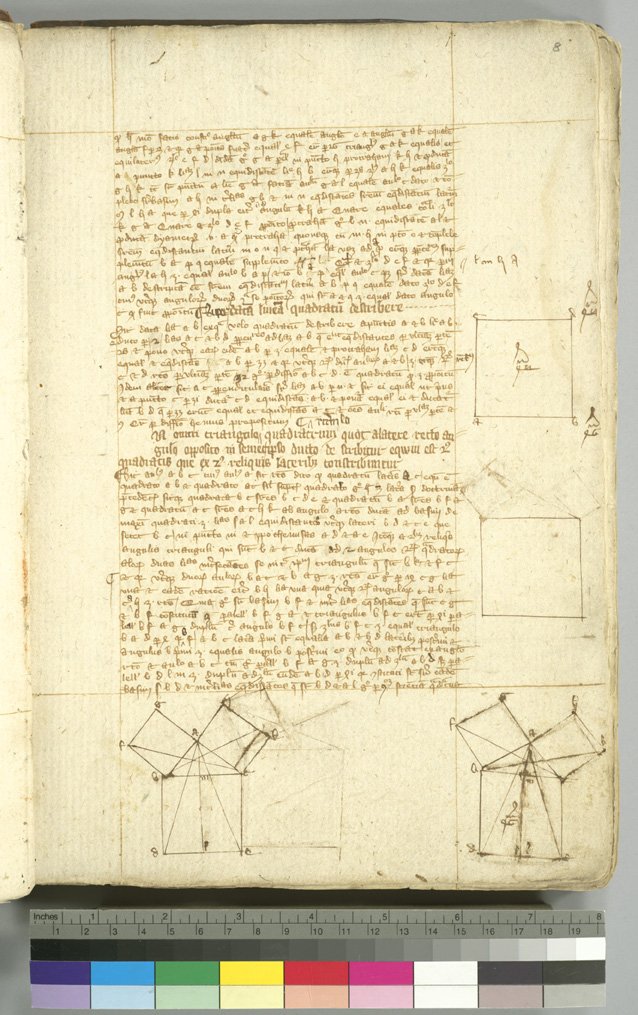- About MAA
- Membership
- MAA Publications
- Periodicals
- Blogs
- MAA Book Series
- MAA Press (an imprint of the AMS)
- MAA Notes
- MAA Reviews
- Mathematical Communication
- Information for Libraries
- Author Resources
- Advertise with MAA
- Meetings
- Competitions
- Programs
- Communities
- MAA Sections
- SIGMAA
- MAA Connect
- Students
- MAA Awards
- Awards Booklets
- Writing Awards
- Teaching Awards
- Service Awards
- Research Awards
- Lecture Awards
- Putnam Competition Individual and Team Winners
- D. E. Shaw Group AMC 8 Awards & Certificates
- Maryam Mirzakhani AMC 10 A Awards & Certificates
- Two Sigma AMC 10 B Awards & Certificates
- Jane Street AMC 12 A Awards & Certificates
- Akamai AMC 12 B Awards & Certificates
- High School Teachers
- News
You are here
Mathematical Treasures - Euclid's Elements in a 14th century manuscript

This image is f. 5 from a late 14th century manuscript containing the first five books of Euclid's Elements in Latin translation. The manuscript probably comes from England, but the scribe is unknown. This page contains four propositions from Book I with their diagrams. First is proposition 26 (at the top), which is the AAS congruence theorem. Next is proposition 27, stating that if a line falling on two straight lines makes the alternate angles equal, then the two lines are parallel. Proposition 28 states that if such a lines an exterior angle equal to the opposite interior angle or makes the interior angles on one side equal to two right angles, then the two lines are parallel. And finally, proposition 29 is the converse to both propositions 27 and 28 and is the first proposition in the Elements requiring the famous parallel postulate.

This page, f. 8, contains propositions 46 and 47 of Book I. Proposition 46 demonstrates how to construct a square on a give straight line, while proposition 47 is the Pythagorean Theorem. Note that the scribe has two versions, neither very neat, of the famous diagram illustrating Euclid's proof of this theorem.

This page is f. 10, and contains three results from Book II, often characterized as results in geometric algebra. Proposition 7 states that if a straight line is cut at random, then the sum of the square on the whole and that on one of the segments is equal to twice the rectangle, one of whose sides is the given line and the other the given segment, together with the square on the second segment. Proposition 8 states that if a straight line is cut at random, then the sum of four times the rectangle whose sides are the whole and one of the segments and the square on the other segment is equal to the square on the whole line together with the original segment. Finally, proposition 9 states that if a straight line is cut into equal and unequal segments, then the sum of the squares on the two unequal segments is equal to twice the square on half the original line plus twice the square on the segment between the points of section. All of these propositions can be translated into algebraic results and easily checked, but Euclid treats these as geometric propositions and draws diagrams (in the first two propositions) confirming the proposed equality of areas. He gives a somewhat different proof of proposition 9, using the Pythagorean Theorem, but the scribe, in the diagram at the bottom, seems to have drawn the squares of each application of the Pythagorean Theorem in the proof and used these to demonstrate explicitly the equality of areas.
Frank J. Swetz and Victor J. Katz, "Mathematical Treasures - Euclid's Elements in a 14th century manuscript," Convergence (January 2011)




